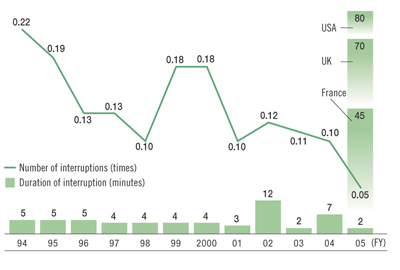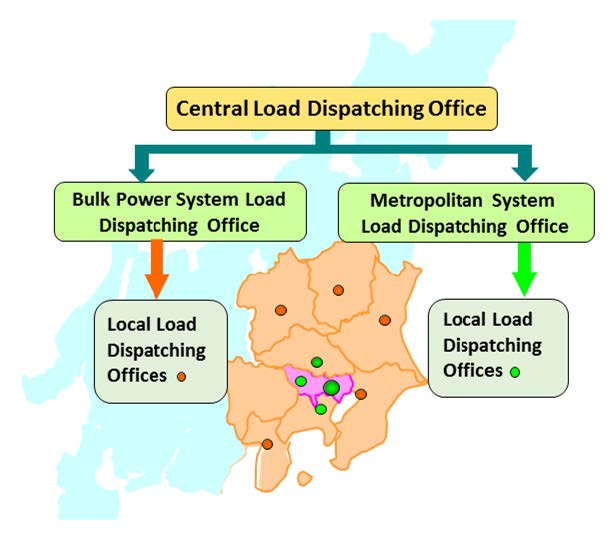
TEPCO's power grid is composed of 40,000 kilometers of transmission lines. In the event of a malfunction along one route, the multiplex design of this system allows power to be transmitted over an alternate route. In addition, a wide-area flexible network has been established, using shared transmission lines to link power companies nationwide. This network provides increased stability and keeps costs down by allowing electric power companies to supply power to each other.
As of March 31, 2004, TEPCO had 1,572 transformer substations, which control voltage and stabilize current to facilitate the efficient transmission of power from the power plant to the consumer with a minimum of loss.
Distribution lines are the final pathways for delivery of power to the customer from a remote power plant. These lines convey power at the desired voltage over short distances.
TEPCO's dedicated power communications network allows the monitoring of power network conditions and communications among the Company's various facilities. This network is used to adjust the output of power plants and in the compilation of data from electric power facilities and the transmission of needed guidance. The network normally uses microwave radio transmission and fiber-optic communications technologies, but in a natural disaster can switch to satellite communications.
(Click here → enlargement)
Duration and Number of Annual Power Outages per Customer (TEPCO)

Operation of Power Systems
Electricity cannot be stored. Therefore the amount of power generation (supply) must be adjusted to the power consumption (demand) which varies from time to time to maintain a balance between supply and demand. In order to supply electricity continuously and consistently, the power system must be operated in a stable manner at all times.
For this purpose, we should develop and maintain a suitable system configuration according to system conditions, regulate power flows on electric power facilities, and maintain system stability and voltage stability in addition to demand-supply control.
Load Dispatching Offices
It is necessary to operate the various facilities integrally in accordance with power demand and system conditions. To achieve this, TEPCO has set up "Load Dispatching Offices" at 12 locations to operate power stations, substations, and transmission lines. Load dispatching offices are responsible for proper operations of each part of the power system assigned to these individual offices.
The Central Load Dispatching Office has the main duty of constantly adjusting power output according to varying power demands in consideration of system conditions. It is also responsible for supervising and controlling the entire power system and also administering the various activities conducted by the load dispatching offices.
The system load dispatching offices and local load dispatching offices are in charge of power system control, including network configuration management, according to generating scheduling, voltage management, and power flow management at power stations and substations.

© Tokyo Electric Power Company Holdings, Inc.